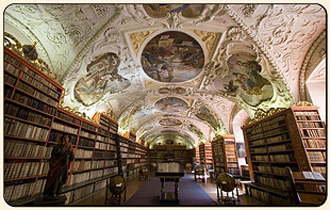| |

Prague Castle - Hradcany Quarter
The name Hradcany derives from the
Czech word Hrad, which means Castle. In the past there actually was
a castle here, founded in the
9th century and, unfortunately, long gone. Today it is a complex
of buildings, courtyards, palaces, churches and chapels, with fascinating
accessory
buildings
and side-streets.
Hradcany was rebuilt several times under the reign of Charles IV,
Rudolf II and the last Habsburgs. From your hotel, we first
drive to the upper part of Hradcany, through Strahov, Loreto and
then on
(and in) to explore the present day Prague Castle.
Strahov Monastery
An enormously important discovery was made in 1140, by King
Vladislav I, when foundations of one of the oldest Roman complexes
in Europe were discovered beneath the exterior of the Strahov
Monastery. Brickwork revealed in numerous parts of the Monastery,
clearly shows its Roman origins. Bear in mind, that 'discovery'
was made some nine-hundred years ago, an indication of the
length and depth of Prague's historic background.
The building passed through several stages of development
since 1142; however the original Roman structure has not been
entirely erased by subsequent Early-Gothic reconstruction and
Baroque alterations. |
 |
Loreto Square
Entering Loreto Square you will be stunned by the sheer mass
of Cernin Palace, built after 1669 in the style of Italian
Renaissance architecture and modelled after a project by Italian
architect, Francesco Caratti. You'll note in your tours that
a great deal of the architecture in Prague is derivative of
the Italian styles of the times.
The whole concept of the building and its grandeur show the
influence of the emerging Baroque period. On the opposite side
of Loreto Square, you can admire a structure of the Loreto
complex containing the Loreto treasury, a carillon, a church
and a Santa Casa (in Italian, 'holy house,' the reputed house
in which the Virgin Mary lived at Nazareth) surrounded by cloisters
which house several chapels. The Loreto was founded during
the 17th century by Catharine of Lobkowicz. Loreto contains
the well-known Loreto treasure of approximately 350 items of
great artistic value, the most precious of which is a diamond
monstrance decorated with 6,222 diamonds.
On the stroke of every hour the Marian song rings out from
the 27-bell carillon. The core of the building is the above-mentioned
copy of Santa Casa, designed by G. B. Orsi between 1626 and
1627. |
 |
Hradcany Square
This accumulation of palace buildings and chateaux leaves
no doubt that this is the place where 'representation' was
a major concern. At the bottom of Hradcany Square, an impressive
grille guards the entry to the castle, adorned by the sculptures
of Battling Giants. In the sight of the Castle nobody wanted
to be left behind. As a result, splendid noble palaces cluster
as closely as possible to its vicinity.
One of them is an Early-Baroque structure with two towers,
the Tuscany Palace. The Schwarzenberg Palace, with its rich sgraffito
decoration, represents one of Prague´s most beautiful
and well-preserved Renaissance structures. The interiors house
a representative collection of historic armaments, the property
of the Museum of Military History.
The building situated opposite is the Archbishop´s Palace,
with a Rococo facade. Passing through the gateway on the left,
we come to Sternberg Palace, another Baroque structure that
presently houses a permanent exhibition of the National Gallery.
The last building in the row is the Martinic Palace, a four-wing
Renaissance structure built around 1570.
Proceeding back in the direction of Loreto Square, we pass
the Renaissance structure of the Hradcany Town Hall, dating
from the end of the 16th century, as well as the Baroque building
of the Hrzan Palace.
From Hradcany square we get back in the car, to park near
the side entrance of Prague Castle and continue on foot. |
 |
The Royal Garden and Belvedere Palace
The castle is partly surrounded by beautiful gardens, containing
many valuable historic monuments, such as the Renaissance Ball
Game Hall and The Royal Summer Palace (known as Belvedere).
They were built by Ferdinand I., in the middle of the 16th
century. He was the first Habsburg on the Czech throne.
The Royal Summer Palace was built for Ferdinand ´s wife,
Anne Jagiellon, but the queen did not live long enough to see
it finished, as she died in 1547. The palace is considered
the purest example of Italian Renaissance north of the Alps.
From there the castle, especially its northern part, offers
quite an unusual view. The Renaissance Ball Game Hall, located
in the southern part of the Royal Garden, is a long, narrow
hall once used for aristocratic sport and proves extremely
suitable for summer art exhibitions. On posters, it may be
identified only by its Czech name, “Micovna”. On
the southern side there are absolutely stunning figural sgraffito
works depicting the Four Elements, Virtues and Liberal Arts. |
 |
Now we can enter the Prague Castle itself. |
|
|
|








